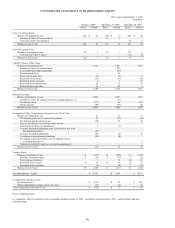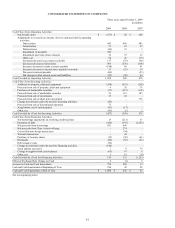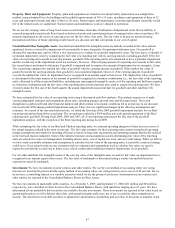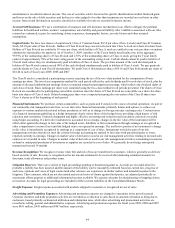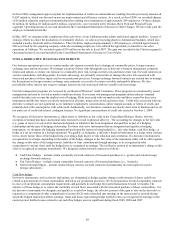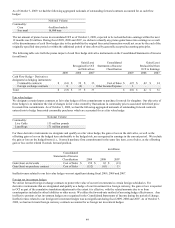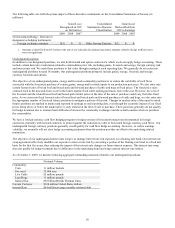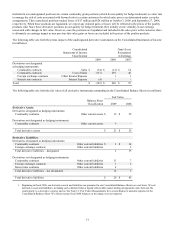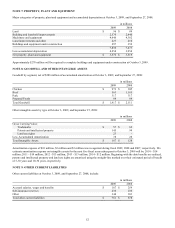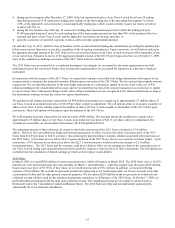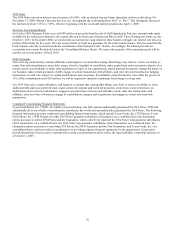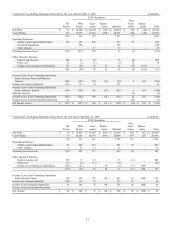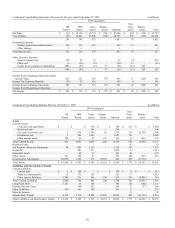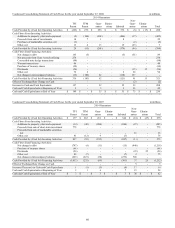Tyson Foods 2009 Annual Report Download - page 50
Download and view the complete annual report
Please find page 50 of the 2009 Tyson Foods annual report below. You can navigate through the pages in the report by either clicking on the pages listed below, or by using the keyword search tool below to find specific information within the annual report.
50
The following table sets forth the pretax impact of these derivative instruments on the Consolidated Statements of Income (in
millions):
Gain/(Loss)
Consolidated
Gain/(Loss)
Recognized in OCI
Statements of Income
Reclassified from
on Derivatives
Classification
OCI to Earnings
2009
2008
2007
2009
2008
2007
Net Investment Hedge - Derivatives
designated as hedging instruments:
Foreign exchange contracts
$(5)
$-
$-
Other Income/Expense
$(2)
$-
$-
1.
Amounts reclassified from OCI relate to the sale of our Lakeside discontinued operation; amounts related to hedge ineffectiveness
were not significant.
Undesignated positions
In addition to our designated positions, we also hold forward and option contracts for which we do not apply hedge accounting. These
include certain derivative instruments related to commodities price risk, including grains, livestock and energy, foreign currency risk
and interest rate risk. We mark these positions to fair value through earnings at each reporting date. We generally do not enter into
undesignated positions beyond 18 months. Our undesignated positions primarily include grains, energy, livestock and foreign
currency forwards and options.
The objective of our undesignated grains, energy and livestock commodity positions is to reduce the variability of cash flows
associated with the forecasted purchase of certain grains, energy and livestock inputs to our production processes. We also enter into
certain forward sales of boxed beef and boxed pork and forward purchases of cattle and hogs at fixed prices. The fixed price sales
contracts lock in the proceeds from a sale in the future and the fixed cattle and hog purchases lock in the cost. However, the cost of
the livestock and the related boxed beef and boxed pork market prices at the time of the sale or purchase could vary from this fixed
price. As we enter into fixed forward sales of boxed beef and boxed pork and forward purchases of cattle and hogs, we also enter into
the appropriate number of livestock futures positions to mitigate a portion of this risk. Changes in market value of the open livestock
futures positions are marked to market and reported in earnings at each reporting date, even though the economic impact of our fixed
prices being above or below the market price is only realized at the time of sale or purchase. These positions generally do not qualify
for hedge treatment due to location basis differences between the commodity exchanges and the actual locations when we purchase
the commodities.
We have a foreign currency cash flow hedging program to hedge portions of forecasted transactions denominated in foreign
currencies, primarily with forward contracts, to protect against the reduction in value of forecasted foreign currency cash flows. Our
undesignated foreign currency positions generally would qualify for cash flow hedge accounting. However, to reduce earnings
volatility, we normally will not elect hedge accounting treatment when the position provides an offset to the underlying related
transaction.
The objective of our undesignated interest rate swap is to manage interest rate risk exposure on a floating-rate bond. Our interest rate
swap agreement effectively modifies our exposure to interest rate risk by converting a portion of the floating-rate bond to a fixed rate
basis for the first five years, thus reducing the impact of the interest-rate changes on future interest expense. This interest rate swap
does not qualify for hedge treatment due to differences in the underlying bond and swap contract interest-rate indices.
As of October 3, 2009, we had the following aggregate outstanding notionals related to our undesignated positions:
Notional Volume
Commodity:
Corn
11 million bushels
Soy meal
73,000 tons
Live Cattle
82 million pounds
Lean Hogs
11 million pounds
Natural Gas
850 billion British Thermal Units
Foreign Currency
$124 million United States dollars
Interest Rate
$64 million average monthly notional debt


